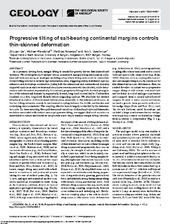Progressive tilting of salt-bearing continental margins controls thin-skinned deformation
Peer reviewed, Journal article
Published version

Åpne
Permanent lenke
https://hdl.handle.net/1956/23503Utgivelsesdato
2019Metadata
Vis full innførselSamlinger
- Department of Earth Science [1050]
Originalversjon
https://doi.org/10.1130/g46485.1Sammendrag
As a primary driving force, margin tilting is crucial for gravity-driven thin-skinned salt tectonics. We investigated how instant versus progressive margin tilting mechanisms influence salt tectonics using an analogue modeling setup where tilting rate could be controlled. Instant tilting resulted in initially high deformation rates, triggering widely distributed upslope extension and downslope contraction. Later, both the extensional and contractional domains migrated upslope as early extensional structures were successively deactivated, while deformation rates decreased exponentially. In contrast, progressive tilting led to downslope migration of the extensional domain by sequentially formed, long-lived normal faults. Contraction localized on a few, long-lived thrusts before migrating upslope. We attribute the distinct structural evolution of thin-skinned deformation, especially in the extensional domain, in the two tilting scenarios mainly to mechanical coupling between the brittle overburden and underlying viscous material. The coupling effect in turn is largely controlled by the deformation rate. By demonstrating the spatiotemporal variations of structural style and kinematic evolution associated with instant versus progressive tilting, we suggest that such variation is identifiable in nature and therefore can provide a new way to analyze margin tilting histories.
